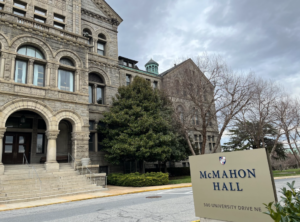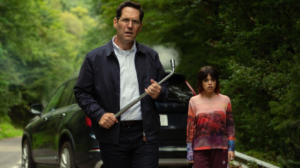“End of Asylum?” With Dr. Julia G. Young

By Eva Lynch
Julia G. Young, professor of the Department of History, spoke to students and faculty about the current legal and political threats to asylum in the United States as well as her personal experience as a volunteer legal advocate for asylum-seekers in South Texas.
This lecture on Wednesday afternoon was sponsored by the McLean Center for the Study of Culture and Values, which the group refers to as one of the only “underground” groups on campus. It follows the George McLean model of bringing people together to address and discuss certain salient current issues in a new philosophical way.
Yeping Hu, the director, addressed the small room before the event. The people crowded therein enjoyed a pizza lunch accompanying Young’s lecture, and anyone in the room could feel the anticipation. The event also had obvious strong pull with faculty members, as many, especially members of the history department, were in attendance. Young’s parents also made an appearance, as they made their own contributions to the topic of her lecture.
Hu noted the center’s Spring Colloquies, of which this lecture was an installment, are honing in on examining the various cultures that are part of the American situation. Following this introduction of the McLean Center, another representative invited Young to continue her work with them as a fellow and to work on a project addressing the topic of the lecture with her own personal experience.
Young graduated from CUA in 2001 and returned as a history professor after pursuing further education. Her expertise includes Latin American studies, more specifically the history of immigration of these peoples into the United States.
Young began her lecture by discussing the history of asylum and seekers thereof in the United States, primarily focusing on our history as a country of immigrants but also our history as a country that has restricted and excluded immigrants.
She then explained that in order to be granted asylum, you must prove at least one of three things: a well-founded fear of persecution, the persecution was committed by the home government, or the government failed to step in during persecution by government-backed individuals or organizations; or that the persecution was committed on the account of one of five grounds: race, religion, nationality, political opinion, or membership in a particular social group.
Per year, only about 24,000 applications are approved out of a pool of over one million.
Young transitioned to discuss recent legislation related to this issue, which she sees as the construction of President Trump’s invisible wall at the border. She noted that many will remember the Muslim ban which was enacted in the president’s first few days in office, and the family separation legislation the following summer. However, following the nationwide outbursts that ensued, Young said she has noticed more skillful ways to pass legislation dedicated to keeping immigrants without attracting the public eye.
Young expressed a sentiment which she claims is nationwide: the US is falling short of its responsibilities following the 1951 Refugee Convention. As Young said, the president does not need to build a wall anymore because Mexico is the wall.
Lastly, Young transitioned to discuss her personal experiences working at the South Texas Family Detention Center, which houses about 1000 individuals, in Dilley, Texas as an interpreter and legal advocate for women and children asylum-seekers. They had to probe into these women’s darkest times in order to help them prepare for their credible fear interviews.Young described the sight of the border as a chokepoint for immigrants: there are over 60,000 people camping at the border, some in tents and some not, and 16,000 of them are children. They are fleeing victimization in their own countries only to be not let in and victimized daily and nightly by the cartel at the border. They wait for their hearings, which are often not fair and not accessible to illiterate non-English speakers, and are facilitated by judges and translators phoning in from brick-and-mortar courts in Texas. It’s no surprise, says Young, that many individuals and families choose to take their chances with crossing the river and entering the US illegally.
“It was an amazing experience,” Young said of her time in Dilley. “To be able to walk with them through part of their immigration experiences and prepare them for their interview but also be one of the only sympathetic audiences that they might ever have.”
Then the floor opened to questions from the audience, about 30 attendees, and many hands flew up to look more deeply into one of the topics Young was able to mention. Promoted by a question about the comparison between the current migration and Central American immigration in the 1990s and 2000s, Young discussed how the “emergency” status of the border crisis may be more political than realistic and what effects that has on Americans’ perception of the issue. According to Young and another History Department scholar in the audience, there has been a demographic shift in terms of immigrants, which can be seen by the family units and children making the journey to the border today as opposed to the single men which made the trek more often 20 to 30 years ago.
Young recalled feeling helpless herself when she first started hearing about this controversial issue, and she encourages students to reach out to her if they are interested in helping with this cause, as she knows of many organizations dedicated to it, located both along the border and more locally in D.C. She invited people to remember that it took until 1965 to fully dismantle the outdated immigration laws of the 1920s; the Catholic Church was instrumental in this shift, and so too can we be.







